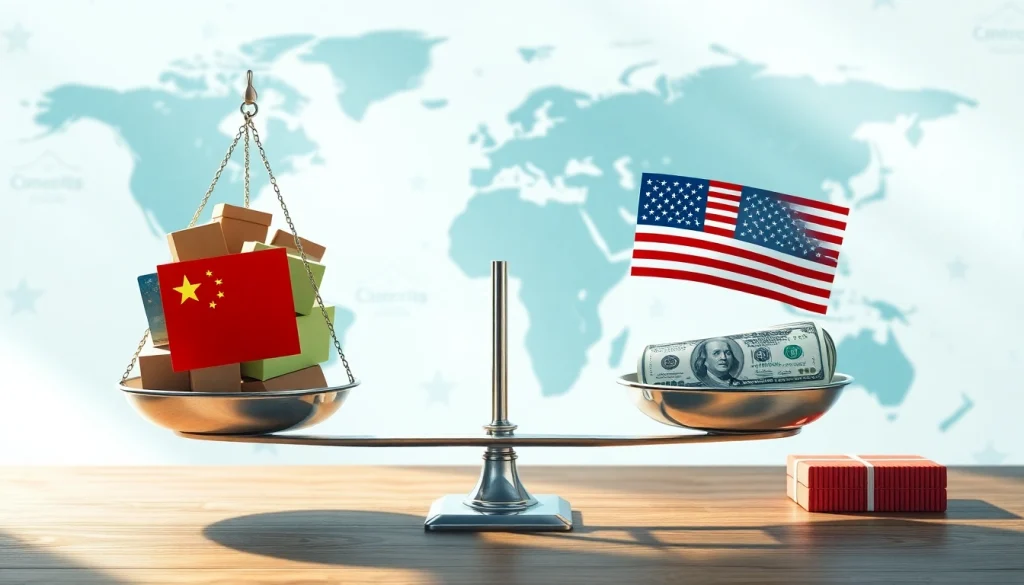The Basics of Import Tariffs Related to China
What Are Import Tariffs?
Import tariffs are taxes imposed by a government on goods and services brought into the country from abroad. These tariffs can significantly affect international trade dynamics, influencing prices, demand, and the competitive landscape between domestic and foreign producers. Import tariffs are generally used as a tool to protect local industries from foreign competition by making imported goods more expensive. This, in turn, encourages consumers to purchase domestically produced items.
When focusing on import tariffs china, understanding the scope and impact of these tariffs becomes vital, especially as they relate to the significant trade relationship between the U.S. and China. Tariffs can vary widely based on the type of product and the country of origin, and can be a point of political contention between nations.
Current Tariff Rates on Chinese Goods
As of 2025, the U.S. has established a tiered structure of tariffs on imports from China. For instance, the tariff on many consumer goods remains at 30%, a significant reduction from earlier peaks. Additionally, the recent trade agreement stipulates a 55% tariff on specific categories of goods, with a focus on rare earth minerals and other high-demand items. This creates a complex fiscal environment where simultaneous rates can exist depending on the product category.
The current landscape shows that tariffs are not only high but also complex, including both baseline and called ‘reciprocal’ tariffs that aim to balance trade levels. Chinese exports are also met with varied tariffs, including a standard 10% rate, depending on the goods involved, showcasing a dynamic tariff environment that responds to ongoing political negotiations.
Factors Influencing Tariff Changes
Several factors can lead to changes in import tariff rates on Chinese goods. Political relations between the U.S. and China play a significant role, especially in the context of ongoing trade negotiations and historical grievances over trade practices like intellectual property theft and currency manipulation. Economic indicators, such as inflation rates and domestic job markets, can also sway tariff policies. Furthermore, lobbying from various industry groups can lead to adjustments in tariff rates to protect or promote specific sectors. Awareness of these factors can equip businesses and consumers with the knowledge to anticipate possible changes in tariffs.
Historical Context of U.S.-China Tariff Relations
The Trade War Origins and Initial Tariff Impositions
The U.S.-China trade war began in earnest under the administration of President Trump, who imposed significant tariffs on a range of goods coming from China. The initial wave of tariffs was part of an effort to counterbalance the trade deficit that the U.S. faced. Beginning in 2018, tariffs were set at 25% on approximately $50 billion worth of Chinese imports. This was intended to pressure China into reforming its trade practices, particularly in technology and intellectual property rights.
Negotiations took on a more aggressive tone as the conflict escalated, with both sides imposing further tariffs on each other’s goods, leading to a complex interplay of economic tactics and retaliatory measures. By the time the trade war had been in effect for a few years, both nations were entrenched in a costly back-and-forth over tariffs and trade practices.
Key Agreements and Their Impacts
Significant agreements emerged as negotiations unfolded, including the Phase One Agreement that was signed in January 2020. This agreement committed China to increase its purchases of U.S. goods and laid the groundwork for reducing tariffs on certain items. However, compliance with this agreement has been shaky at best, with critics noting that many targets remain unmet. Additionally, this agreement was only a temporary measure, raising questions about its long-term viability given the fundamental trade imbalances that still exist.
Subsequent deals have often clarified but not eliminated tariffs, leading to a persistent state of negotiation rather than resolution, continuing the volatility in the trade relationship between the two nations.
Timeline of Major Tariff Changes
Understanding the timeline of significant tariff changes can help businesses and analysts gauge future trends. The following events illustrate key milestones:
- July 2018: The U.S. imposes a 25% tariff on $34 billion worth of Chinese goods.
- September 2018: Additional tariffs on $200 billion worth of goods are announced, raising the total to approximately 30%.
- January 2020: The signing of the Phase One Agreement leads to mixed compliance and ongoing disputes.
- May 2025: New tariffs reflecting updated negotiations lead to a reported effective tariff rate of up to 126.5% on select goods.
This timeline not only represents chronological events but also the evolving nature of tariffs as leverage in diplomatic regulations.
Economic Effects of Import Tariffs on China
Impact on U.S. Imports and Exports
The tariffs imposed on Chinese goods have had significant implications for both imports and exports. For U.S. consumers, the increased costs of imported goods lead to higher retail prices. This set of tariffs is estimated to have affected billions in consumer spending, changing shopping habits and prompting a shift towards domestic products. Meanwhile, U.S. exports to China have seen fluctuations due to retaliatory tariffs imposed by China in response to U.S. tariffs, affecting American businesses and farmers who rely on the Chinese market.
Data shows that export volumes to China declined significantly during peak tariff periods. This impacts not only large corporations but also small businesses that depend on overseas markets to sustain their growth.
Effects on Chinese Manufacturers
Chinese manufacturers represent a critical element in the trade equation. They have faced rising production costs due to tariffs imposed by the U.S., which has altered their pricing structures and profitability. Many manufacturers have started to seek alternative markets, diversifying exports to countries unaffected by tariffs, or attempting to make their supply chains less reliant on U.S. imports.
Moreover, some manufacturing firms have relocated operations to countries with lower labor costs or more favorable trade policies to mitigate the fallout from tariffs. The adaptability of these manufacturers to external pressures reflects the changing landscape of global supply chains.
Global Trade Dynamics and Shifts
The ongoing tariff situation has led to shifts in global trade dynamics, pushing countries to revise their trade policies. For instance, some nations have positioned themselves as substitutes for Chinese manufacturing, drawing businesses seeking to avoid high tariffs. Vietnam, for example, has seen an influx of foreign direct investment as companies look to establish operations that can sidestep U.S. tariffs. This movement is noted not only for its economic implications but also its potential geopolitical effects, as relationships reshuffle among global trading partners.
Consumer Implications of Tariffs on Imports from China
Increased Prices and Product Availability
Consumers are directly impacted by import tariffs through increased prices on goods. As tariffs are passed down the supply chain, consumers may see costs rise significantly, especially for everyday items, technology, and consumer goods that are primarily manufactured in China. Price fluctuations may lead to decreased availability of some products as retailers adjust to the new economic landscape.
In some instances, markets may also experience shortages as suppliers hesitate to bring affected goods to market, anticipating further price hikes or retaliatory tariffs from foreign markets.
Long-Term Market Adjustments
The market’s response to tariffs can lead to long-term adjustments in both consumer preference and supply chain management. Retailers may opt for local sources or alternative suppliers that do not incur tariffs, changing the landscape of available products. Over time, these shifts can foster greater economic resilience and market diversification but may temporarily lead to limited choices for consumers and higher prices.
Additionally, brands must navigate consumer sentiment, which can be influenced by views on whether tariffs help or hurt domestic markets. Growing awareness of such economic intricacies can foster more informed consumer behavior.
Consumer Perspectives on Tariff Policies
The complexities of tariff policies elicit diverse opinions among consumers. Some view tariffs as necessary protection for domestic industries, while others see them as detrimental, leading to higher prices without significant benefits. Understanding these perspectives is crucial for businesses and policymakers alike, as they shape the discourse surrounding trade policies and influence political opinions.
Moreover, this sentiment can drive consumer behavior towards brands perceived as patriotic or supportive of local economies, prompting businesses to align themselves closer to consumer values in their marketing strategies.
Future Trends and Predictions for Import Tariffs on China
Predicted Policy Changes and Their Rationale
The future of import tariffs on China is likely to remain tumultuous, with numerous factors driving potential changes in policy. Experts predict possible reductions if diplomatic relations improve, particularly with tensions easing or through negotiations focusing on trade imbalances and mutual economic benefits.
Conversely, if geopolitical tensions escalate, tariffs may maintain their elevated rates or even increase, especially if national security concerns become a focal point of trade discussions. The balancing act is particularly delicate in an era of interconnected supply chains and fluctuating market demands.
Potential Economic Scenarios
As the trade landscape evolves, potential economic scenarios can be anticipated. A stable reduction in tariffs could open doors for increased trade flows between the U.S. and China, benefiting both economies and revitalizing previously strained sectors. Conversely, ongoing or escalating tariffs could lead to further market fragmentation, accelerating trends toward de-coupling economies or pushing nations to form new trading blocks.
Industry experts also observe the potential for increased technological innovations in supply chains that could adapt rapidly to tariff changes. The onus will be on businesses to stay agile and responsive to such shifting economic conditions.
Long-Term Visions for U.S.-China Trade Relations
Long-term trade relations between the U.S. and China will hinge on collaborative dialogue and mutual benefits derived from trade. Striking a balance between national interests and global economic responsibilities is paramount as both nations navigate their roles on the global stage.
Strategically aligning trade policies to foster sustainable growth will benefit both nations economically while promoting stability in global trade relations. The future will inevitably involve complexity, requiring constant evaluation and adaptation.


